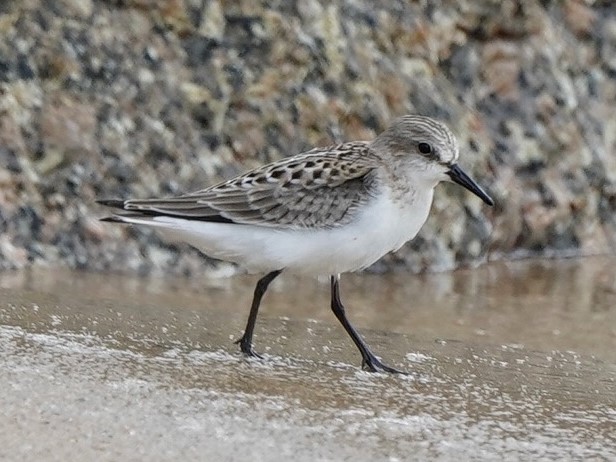Red-necked Stint Calidris ruficollis 紅頸濱鷸
Category I. Abundant passage migrant in spring, uncommon or scarce at other times of the year; primarily occurs on intertidal mudflats of Deep Bay. Numbers appear to be in decline.
IDENTIFICATION

Apr. 2020, James Kwok. Breeding plumage.
13-16 cm. Rather squat stint with a relatively short and thick bill, short neck and large head. In breeding plumage has orange face, throat and upper chest, streaked lower breast, orange in scapulars that contrasts with rather plain grey wing coverts and tertials. Early in breeding season pale fringes obscure the orange colour.

Sep. 2020, Sarawak, Malaysia. Dave Bakewell. Juvenile.
Juvenile shows contrast between greyer wing coverts (more darkly centred on uppers) and rufous fringes to upper scapular and mantle feathers. Crown fairly uniform, lacking an obviously dark central area.

Oct. 2023, Zoe Duan. Juvenile.
The colour tone of juveniles is variable. This bird is rather greyer than average.

Jan. 2023, Sarawak, Malaysia. Dave Bakewell. Non-breeding plumage.
In non-breeding plumage grey brown with pale fringes to upperpart feathers.
VOCALISATIONS
A variety of flight calls are uttered.
DISTRIBUTION & HABITAT PREFERENCE
Most records are from the intertidal mudflats of Deep Bay and adjacent roosting areas at Mai Po NR, but small numbers are regularly reported from drained commercial fish ponds. In recent years up to 75 birds have been recorded at the intertidal Shui Hau, Lantau on spring passage, and in the 1970s at Kai Tak airport up to 65 were recorded. Elsewhere up to 15 birds have been noted on passage at widespread coastal and inland localities in the New Territories and on beaches on the islands of Po Toi, Cheung Chau and Tung Ping Chau.
OCCURRENCE
Red-necked Stint is a passage migrant, abundant in spring but uncommon in autumn, and a scarce winter visitor (Figure 1).
The first migrants can be noted as early as the first week of March, though in most years they arrive in numbers during the third week. The main passage period lasts from the second week of April to the second week of May. The peak counts are 3,756 on 11 April 2010 and 2,700 on 10 April 2009. Very few birds remain at the end of May, while June records occur in only one out of two years. Figure 2 indicates that peak spring counts were in general higher from 1998 to 2010 than in the period since.
In autumn the first birds apparently pass during the last week of July, with the main period of autumn passage extending to the first week of October, though the numbers involved are generally rather low with 50 or fewer birds generally counted. However, exceptional numbers in 2005 included a high count of 885 on 23 August. In most years small numbers spend the winter when the highest count is 49 on 21 January 1998.
This species was first recorded in 1953 by Dove and Goodhart (1955); Macfarlane and Macdonald (1966) reported parties of up to 200 from 14 March to 30 May and up to 20 birds from 1 August to 2 November.
BEHAVIOUR, FORAGING & DIET
Mainly forages in groups constantly picking at intertidal mudflat or muddy areas at roost site.
RANGE & SYSTEMATICS
Monotypic. Breeds in disjunct areas in north and northeast Siberia from the Taimyr east to the Chukotsky peninsula, south to north Kamchatka and occasionally in west Alaska; winters from east India through northern Indochina to south China and south through the Philippines to Indonesia and Australasia (Van Gils et al. 2020). In China a migrant through much of the country with small numbers wintering on the south coast, including Hainan and Taiwan (Liu and Chen 2020).
CONSERVATION STATUS
IUCN: NEAR-THREATENED. Population trend decreasing due to loss of key stopover sites in the Yellow Sea.
Figure 1.

Figure 2.

Dove, R. S. and H. J. Goodhart (1955). Field observations from the Colony of Hong Kong. Ibis 97: 311-340.
Liu, Y. and Y. H. Chen (eds) (2020). The CNG Field Guide to the Birds of China (in Chinese). Hunan Science and Technology Publication House, Changsha.
Macfarlane, A. M. and A. D. Macdonald, revised by Caunter, J. R. L. and A. M. Macfarlane (1966). An Annotated Check-list of the Birds of Hong Kong. Hong Kong Bird Watching Society, Hong Kong.
Van Gils, J., P. Wiersma, G. M. Kirwan, and C. J. Sharpe (2020). Red-necked Stint (Calidris ruficollis), version 1.0. In Birds of the World (J. del Hoyo, A. Elliott, J. Sargatal, D. A. Christie, and E. de Juana, Editors). Cornell Lab of Ornithology, Ithaca, NY, USA. https://doi.org/10.2173/bow.rensti.01

